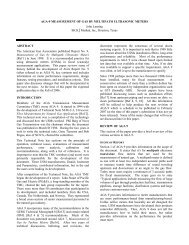Effects and Control of Pulsation in Gas Measurement
Effects and Control of Pulsation in Gas Measurement
Effects and Control of Pulsation in Gas Measurement
Create successful ePaper yourself
Turn your PDF publications into a flip-book with our unique Google optimized e-Paper software.
GLE-Test 3: A Honeywell ∆P transmitter was<br />
connected to a 16' Daniel Junior fitt<strong>in</strong>g with 15<br />
ft. <strong>of</strong> 3/8" O.D. tub<strong>in</strong>g, a small bore (0.187") 5<br />
valve manifold, <strong>and</strong> 1/2" ball valves at the orifice<br />
taps. At a constant flow <strong>of</strong> 30.19 MMCFD,<br />
gauge l<strong>in</strong>e error measured a negative 0.192 <strong>in</strong>.<br />
wc. Annualized this would result <strong>in</strong> a<br />
measurement error <strong>of</strong> $143,529.00 as shown<br />
below <strong>in</strong> Figure 9.<br />
Figure 9<br />
Elim<strong>in</strong>at<strong>in</strong>g or M<strong>in</strong>imiz<strong>in</strong>g GLE<br />
As mentioned previously, numerous gas<br />
contracts now <strong>in</strong>clude pulsation magnitude<br />
clauses. Many transmission companies<br />
require the <strong>in</strong>stallation <strong>of</strong> acoustic filters to<br />
m<strong>in</strong>imize pulsation levels <strong>and</strong> %SRE.<br />
Test<strong>in</strong>g has shown that <strong>in</strong> some cases<br />
gauge l<strong>in</strong>e error may cont<strong>in</strong>ue to be present<br />
after the <strong>in</strong>stallation <strong>of</strong> an acoustic filter <strong>and</strong><br />
when % <strong>of</strong> SRE read<strong>in</strong>gs are very low - <strong>in</strong><br />
some cases 0.1 % SRE.<br />
Because <strong>of</strong> the many variables <strong>in</strong>volved <strong>in</strong><br />
gauge l<strong>in</strong>e error, such as pulsation levels,<br />
gauge l<strong>in</strong>e lengths <strong>and</strong>/or diameters,<br />
operat<strong>in</strong>g pressure, gas density, <strong>and</strong> gas<br />
velocity, it is extremely difficult to observe a<br />
measurement location <strong>and</strong> predict what<br />
gauge l<strong>in</strong>e error, if any, will be present. The<br />
only way to determ<strong>in</strong>e the presence <strong>of</strong> gauge<br />
l<strong>in</strong>e error is through test<strong>in</strong>g.<br />
An alternative to test<strong>in</strong>g for gauge l<strong>in</strong>e error<br />
at each <strong>in</strong>stallation is to <strong>in</strong>stall the transmitter<br />
6<br />
<strong>and</strong>/or EFM <strong>in</strong> a manner that will m<strong>in</strong>imize or<br />
elim<strong>in</strong>ate gauge l<strong>in</strong>e error.<br />
To m<strong>in</strong>imize gauge l<strong>in</strong>e error when pulsation or flow<br />
phenomena are present, a differential measur<strong>in</strong>g<br />
device should be close coupled to orifice fitt<strong>in</strong>gs with<br />
equal lengths <strong>of</strong> large bore (0.375" I.D. or greater)<br />
constant diameter gauge l<strong>in</strong>es.<br />
This can be accomplished us<strong>in</strong>g a short length <strong>of</strong> 1/2"<br />
O.D. <strong>in</strong>strument tub<strong>in</strong>g <strong>and</strong> full open<strong>in</strong>g ball valves on<br />
the orifice fitt<strong>in</strong>g <strong>and</strong> measurement device. However,<br />
<strong>in</strong> this type <strong>of</strong> <strong>in</strong>stallation the numerous matt<strong>in</strong>g <strong>of</strong><br />
female NPT connections create small 'volume<br />
chambers," which could produce gauge l<strong>in</strong>e shift<br />
(pulsation rectification effects).<br />
If the full port 1" ball valves are used, it is very easy to<br />
shock one side <strong>of</strong> the measurement device with full<br />
l<strong>in</strong>e pressure. When this occurs, it may create a<br />
significant static shift <strong>in</strong> the calibration <strong>of</strong> the<br />
transmitter not detectable under normal calibration<br />
procedures.<br />
A more feasible method is the Direct Mount<strong>in</strong>g<br />
System as shown <strong>in</strong> Figure 10. With over 10,000<br />
<strong>in</strong>stallations currently <strong>in</strong> service, this method <strong>of</strong> close<br />
coupl<strong>in</strong>g transmitters or a self-conta<strong>in</strong>ed EFM to the<br />
orifice fitt<strong>in</strong>g cont<strong>in</strong>ues to ga<strong>in</strong> wide acceptance with<strong>in</strong><br />
the <strong>in</strong>dustry.<br />
Utiliz<strong>in</strong>g a pair <strong>of</strong> stabilized connectors for safety, <strong>and</strong><br />
roddable large bore (0.375" I.D.) s<strong>of</strong>t seat <strong>in</strong>strument<br />
manifolds, the transmitters are located as close as




